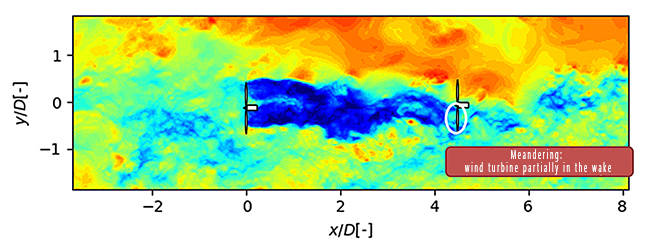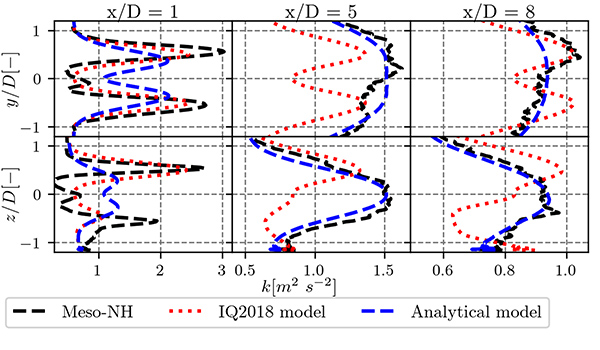Thesis prepared by Erwan Jézéquel: « Simulations de sillages d'éoliennes en conditions atmosphériques réelles : des simulations aux grandes échelles aux modèles analytiques » ("Wind turbine wake simulations in real atmospheric conditions: from large scale simulations to analytical models")
In the wake zone located behind each wind turbine, wind velocity is reduced and turbulence increased. This results in a reduction in the lifespan of machines located downstream as well as a decrease in a windfarm’s overall electricity production.
To limit these effects and help optimize the siting of turbines on windfarms, analytical wake models exist in the literature but they incorporate numerous simplifying hypotheses concerning wind turbines and their environment. In particular, meandering1, illustrated in figure 1, is often not explicitly taken into account in stationary flow models and it is merely assumed that it contributes to the evolution of wake in the same way as diffusion. However, these oscillations modify the form and evolution of speed and turbulence profiles in very different ways. Hence, because of meandering, a downstream turbine may alternatively be located inside or outside wake created upstream. Its velocity deficit will be less than is calculated by stationary models. Conversely, actual turbulence, and therefore the fatigue stress, will be higher.

Blue: low velocities
Red: high velocities
Distances scaled by the diameter of the wind turbine.
Meandering is caused by the large atmospheric vortices and is directly related to the state of the atmospheric boundary layer2 (ABL). ABL instability increases with the extent of thermal and mechanical phenomena, with a direct impact on the development of meandering.
In order to directly simulate the effect of the ABL on meandering (wind and turbulence profiles), IFPEN researchers use a numerical code (Meso-NH) developed by the French Meteorological Research Center and the French Aerology Laboratory. This high-fidelity code, based on Navier-Stokes equations, was specifically created to model phenomena within the ABL and we were thus able to use its results as a reference. We were able to precisely simulate the wake generated by a single turbine for a stable, unstable and intermediate case. This enabled us to demonstrate commonly accepted results in the literature, while at the same time clarifying certain underlying assumptions that are rarely detailed [1].
The results obtained firstly confirmed that the form of the turbulence profile in a turbine’s wake is influenced by meandering and that, compared to a neutral situation, ABL instability causes the profile to rapidly evolve from a bimodal form to a unimodal form.
These findings then formed the basis for the proposal of a new analytical model to describe turbulence in a turbine’s wake taking into account meandering [2]. This is the first analytical model based on physics rather than on an entirely empirical approach to predict an added turbulence profile.
Figure 2 illustrates the fact that the analytical model developed during this research (in blue) makes it possible to find different simulated profiles with Meso-NH, unlike the models found in the literature (example in red), which systematically predict a bimodal form due to calibration with respect to neutral cases.

Black: Meso-NH
Red: analytical literature model
Blue: proposed analytical model
To continue this research, a calibration of the model will be proposed, based on other high-fidelity Meso-NH simulations. This will make it possible to precisely predict turbulence profiles as a function of atmospheric conditions while keeping calculation costs very low.
1- Wake oscillations.
2- The lowest part of the atmosphere, in contact with the planet’s surface, the behavior of which is directly influenced by friction with the latter.
References
-
Erwan Jézéquel, Frédéric Blondel, Valéry Masson 2022. Breakdown of the velocity and turbulence in the wake of a wind turbine – Part 1: large eddy simulations study, Wind Energy Science, 2022-46.
>> https://doi.org/10.5194/wes-2022-46 - PREPRINT ACCEPTED (publication pending)
-
Erwan Jézéquel, Frédéric Blondel, Valéry Masson 2022. Breakdown of the velocity and turbulence in the wake of a wind turbine – Part 2: analytical modeling, Wind Energy Science, 2022-47.
>> https://doi.org/10.5194/wes-2022-47
Scientific contact: erwan.jezequel@ifpen.fr





